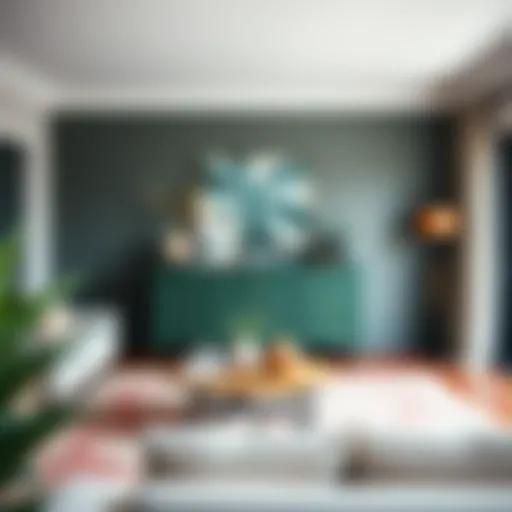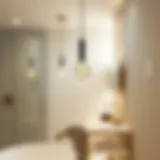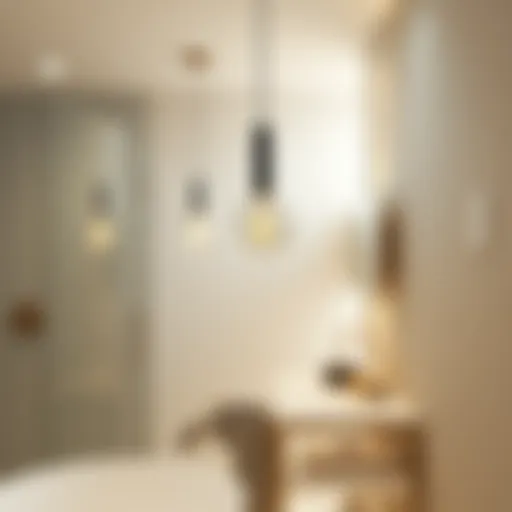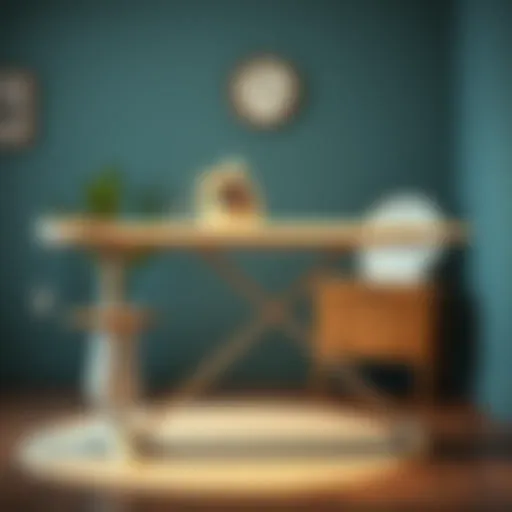Exploring the Role of Light Teal Curtains in Design
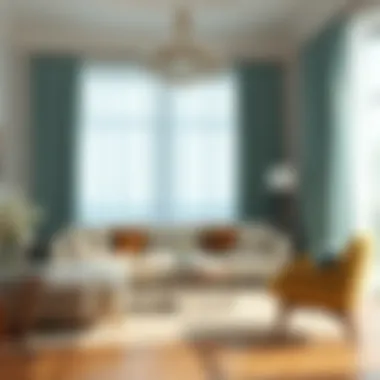

Intro
The choice of curtains often reflects an array of considerations that gracefully play into the wider theme of interior design. Light teal curtains, in particular, have gained traction in recent years, owing to their versatile nature and ability to complement a broad array of color palettes. They can evoke feelings of calmness and serenity while simultaneously serving functional roles, such as regulating light and privacy. Beyond their practical aspects, light teal curtains contribute a chic aesthetic that brings both life and elegance to any room.
This article provides a comprehensive examination of light teal curtains, moving beyond mere aesthetics to explore their impact on functional design elements. We will delve into current trends, the best styles and fabrics that align with this hue, and practical strategies for integrating light teal into your home decor seamlessly. Additionally, advice on selecting and upkeeping these curtains will ensure that they remain a lasting component of your interior design scheme.
Design Trends
Current Trends in Furniture Styles
In the dynamic world of home decor, the colors and designs of furniture frequently dance in alignment with transformative trends. Light teal, a color that beautifully balances between blue and green, often finds itself harmonizing with contemporary as well as classic styles.
- Scandinavian influences have embraced light teal, pairing it with minimalist furniture that boasts natural wood tones.
- Mid-century modern styles often highlight this shade alongside bold, geometric patterns, where eclectic yet balanced pieces come to life.
- Furthermore, the current trend towards sustainable materials makes light teal curtains a fine companion to eco-friendly furniture made from reclaimed or sustainably sourced wood, aligning aesthetic choices with environmental consciousness.
These styles allow for a range of combinations, where light teal can act as a statement piece or a subtle enhancement in a more muted palette.
How to Incorporate Trends into Your Space
Integrating light teal curtains into your home isn’t simply about hanging them up; it’s an art. Here are some pointers to ensure a cohesive design that feels intentional rather than accidental:
- Contrast carefully: If your walls feature warm tones, light teal can provide a refreshing splash without clashing. Consider colors such as soft coral or earthy beiges paired with your curtains to form a relaxing atmosphere.
- Layer textures: Mixing various textures enhances depth. If your curtains are sheer, blend them with heavier fabrics, like a plush sofa or cotton-blend throws, that harmonize while adding richness.
- Accessories: Use cushions or an area rug with hints of teal to tie the room together. Soft furnishings can echo the curtain's color, creating a balanced yet sophisticated look.
Be mindful of the scale. Large rooms can carry a bolder teal, while smaller spaces may call for gentler shades or patterns.
Buying Guides
Choosing the Right Furniture for Different Rooms
Selecting the perfect furniture to complement light teal curtains requires a thoughtful approach. Each room has its unique vibe, which should be respected while selecting additional decor.
- In living rooms, prioritize comfortable seating that encourages gathering. Neutral upholstered pieces can form an inviting backdrop, allowing the curtains to pop.
- In bedrooms, opt for calming hues and soft textures. A wooden bed frame can harmonize beautifully with light teal, promoting a tranquil sleeping environment.
- For home offices, a desk made from reclaimed wood works well with teal shades, fostering creativity without overwhelming the senses.
Tips for Assessing Quality and Value
When choosing curtains and furniture, it is essential to invest wisely. Focus on these aspects:
- Fabric Type: Choose durable materials such as linen or cotton blends for durability and ease of maintenance.
- Stitching and Finishing: Check the quality of seams and finishes—investing in well-made pieces typically pays off long-term.
- Brand Reputation: Research brands like West Elm or IKEA that focus on sustainability; they often provide high-quality options without breaking the bank.
By keeping these elements in mind, you can curate a living space that is not only attractive but also functional and suited to your lifestyle.
Prolusion to Light Teal Curtains
Light teal curtains hold a unique position in the realm of interior design, serving not just as mere window treatments but as pivotal elements in creating a harmonious living space. This shade, often described as a gentle blend of blue and green, evokes a sense of tranquility and freshness, which can significantly enhance the atmosphere of a room. When incorporated thoughtfully, light teal curtains can breathe new life into any interior, transforming it from mundane to enchanting.
One of the key benefits of light teal curtains is their versatility. They can seamlessly adapt to various styles, from modern minimalism to coastal chic, making them a favorite among homeowners and designers alike. Moreover, the color has the distinct ability to enhance the natural light that floods a room, creating an inviting and airy feel. It is not just about aesthetics; practicality plays a vital role too. The right pair of curtains can regulate light, provide privacy, and contribute to the overall energy efficiency of a home.
As we navigate through the different aspects of light teal curtains, understanding their definition within interior design is crucial. The color not only reflects personal style but also influences the mood of a space. In this exploration, we will delve into historical trends surrounding color in design, offering context that enriches our appreciation of why light teal, in particular, is not just a passing trend, but a lasting choice.
"Color is the keyboard, the eyes are the harmonies, the soul is the piano with many strings." — Wassily Kandinsky
By contextualizing light teal within the broader framework of interior design history, we can glean insights into its increasing popularity in contemporary homes. Curious about where this vibrant color originates and how it can be utilized? Let's begin by defining light teal and its role in elevating daily life through the simple act of dressing our windows.
The Aesthetic Appeal of Light Teal Curtains
The aesthetic appeal of light teal curtains is more than just surface-level; it encompasses a duality of function and beauty that can transform a room into a sanctuary. Using light teal curtains can create visual intrigue without overwhelming the space. This section delves into the specific elements that contribute to the allure of these curtains and considers the functional benefits that accompany their use in interior design.
Enhancing Natural Light
One of the primary characteristics that make light teal curtains a coveted choice is their ability to enhance natural light within a room. When sunlight filters through sheer or lightly colored fabrics, it illuminates the space with a soft glow. Light teal, being a pale shade, doesn’t block out too much light while still providing a degree of privacy. This balance is essential in living areas where brightness and warmth are desired.
- Reflective Qualities: Light teal curtains often have reflective properties that can bounce light around the room, making even the smallest spaces feel more open and airy.
- Color Interaction: The color teal can complement various other hues. When paired with warm sunlight, it takes on a different character altogether—a gentle, tranquil vibe that invites relaxation.
"Light teal curtains have an uncanny ability to catch the morning rays and transform them into a celestial glow, illuminating every nook and cranny."
Creating a Calming Atmosphere
Another noteworthy aspect of light teal curtains is their contribution to a calming atmosphere within the home. Color psychology suggests that shades of blue and green, including teal, often evoke feelings of tranquility. Incorporating light teal into your decor can serve as a subtle signal to your mind that it’s time to unwind.
- Softer Aesthetic: The delicate nature of light teal can soften harsh lines and edges in a room, merging them into a cohesive whole. This is especially beneficial in spaces that are predominantly filled with angular furniture or stark decor.
- Versatile Pairing: Light teal can harmonize with a variety of colors, enhancing relaxation throughout different settings. Imagine light teal curtains paired with taupe walls or muted greys— the outcome would yield a sophisticated gentleness.
Choosing light teal curtains not only enriches the aesthetics of a space but contributes to a sense of peace and comfort. In today’s fast-paced world, where finding tranquility in one’s home is increasingly important, these curtains can play a significant role.
In summary, the aesthetic appeal of light teal curtains arises from their ability to both enhance natural light and foster a calming environment. As we explore more about their integration in design themes and other aspects in subsequent sections, the impact of this graceful shade will become even clearer.
Styles and Patterns of Light Teal Curtains
The styles and patterns of light teal curtains can make or break an interior space. These curtains aren’t just functional elements; they play a pivotal role in setting the mood and aesthetic of a room. Choosing the right style or pattern can echo the personality of the homeowners, while also harmonizing with the existing decor.
When considering light teal curtains, it’s important to focus on how they can complement or contrast with other design elements. The right style can enhance the visual appeal, while the choice of pattern brings a layer of uniqueness or texture to the space.
Solid vs. Patterned Designs
When deliberating between solid and patterned designs, one must assess the impact they both carry. Solid light teal curtains can evoke a sense of tranquility, creating a calm backdrop without overwhelming the senses. They can often serve as a neutral canvas on which other elements—like furnishings or wall art—stand out. This plays well in a minimalist setting or a space that already boasts bold colors and patterns.
On the flip side, patterned designs—whether they consist of intricate motifs or simple textures—bring vibrance into a room. Patterns can range from geometric shapes to organic forms, adding dynamism and interest. For instance, floral patterns can connect the indoors with nature, which is beneficial in creating an inviting atmosphere.
A choice that merits consideration is the perceived scale of the room. Larger patterns can make a room feel busy, which might not be ideal for smaller spaces, while smaller patterns offer a softer touch. Always keep in mind the specific purpose of the room. A lively pattern might suit a child's room but could clash in a serene reading nook.
Popular Patterns: Stripes and Floral
Among the myriad of options for patterns, stripes and floral designs are especially popular. Stripes, for one, can elongate space and lend a chic, modern feel. They can add a contemporary edge, transforming an ordinary window dressing into a statement piece. Horizontal stripes can create a sense of width, while vertical stripes may make ceilings feel higher, which is a nifty trick for spaces that are narrow or low.
Conversely, floral patterns often evoke a sense of romance and warmth. These patterns can range from delicate, understated designs to bold, oversized prints that draw the eye. Depending on the type of floral pattern chosen, it could evoke a vintage charm or lend to a more bohemian vibe. Integrating floral patterned light teal curtains in a room filled with natural light can bring out the hues beautifully, enhancing the overall aesthetic.
Ultimately, the choice between solid and patterned curtains, as well as the specific design, hinges on personal taste and the intended atmosphere of the space. Tailoring these choices to the needs and character of the room enhances not just the visual appeal but also the overall experience of living within these walls.
Choosing the Right Fabric
Selecting the appropriate fabric for light teal curtains is crucial in transforming your space. Not only does the fabric dictate the aesthetic appeal, but it also influences functionality, durability, and maintenance. Homeowners and designers should consider factors like texture, thickness, and the intended purpose of the curtains before making a decision. The right fabric can enhance the comfort of a room, control light flow, and even contribute to energy efficiency. Ultimately, fabric choice will play a significant role in how the light teal color interacts with other design elements in a space.
Lightweight Fabrics for Sheer Elegance
Lightweight fabrics, such as chiffon or organza, offer a delicate and ethereal quality to light teal curtains. These materials are perfect for creating a soft ambiance that feels airy and inviting. When you allow natural light to filter through, it can create beautiful shadows and reflections, enhancing the overall mood of your room. Consider how a lightweight fabric can softly diffuse bright sunlight, giving your space a tranquil glow instead of harsh brightness.
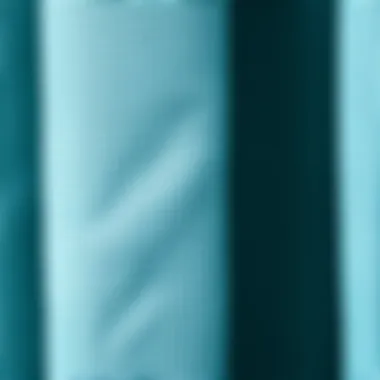

The sheer elegance of lightweight fabrics can be particularly beneficial in smaller rooms or those with limited natural light. They can make a space feel larger and more open, promoting a sense of freedom and freshness. Additionally, these fabrics are often easier to clean and maintain, making them a practical choice for homeowners who value both beauty and simplicity.
"Choosing lightweight fabrics for curtains can significantly affect the atmosphere of your home, transforming it into a personal sanctuary."
Heavier Fabrics for Insulation
Conversely, heavier fabrics, like velvet or canvas, serve a different set of functions while adding a level of sophistication and luxury. These materials are excellent for insulation, helping to regulate indoor temperatures by reducing drafts in cooler months and blocking out excessive heat when it’s sweltering outside. The thermal benefits of thicker fabrics cannot be overstated, especially in homes that aim for energy efficiency.
Moreover, heavier curtains add a touch of drama and elegance, making them suitable for dining rooms or living areas where you want to make a bold statement. When selecting heavier fabrics, consider the color and pattern as well; the rich depth of a light teal might appear even more striking against a heavier texture.
In summary, the choice between lightweight and heavier fabrics hinges on your specific needs in terms of aesthetics and functionality. Each type brings its benefits and can dramatically change the atmosphere of a room, particularly when it comes to light teal curtains.
Integrating Light Teal Curtains with Color Palettes
In the intricate world of interior design, color is not just a visual element; rather, it acts as a powerful tool that can shape moods and influence perceptions. Light teal curtains, with their subtle yet refreshing hue, play a pivotal role in this dynamic by effortlessly merging with various color palettes. Understanding how to integrate these curtains into a chosen color scheme isn't merely a question of aesthetics—it's about curating an environment that reflects individual taste while promoting harmony and balance throughout the space. The consideration of color interactions helps both the practical and the artistic aspects of home decor come alive.
Light teal, sitting comfortably between blue and green, evokes a sense of calmness and tranquility, making it a versatile choice for many homeowners and designers. This unique color can serve as a focal point in a room or as a subtle accent that ties together disparate elements.
When diving into this topic, it’s crucial to explore the elemental factors that can enhance visual appeal, such as temperature, contrast, and the psychology of color.
Complementary Colors and Their Effects
Complementary colors create a visual dialogue that can either uplift or balance a space. In the context of light teal, complementary shades include vibrant corals, rich oranges, and deeper blues. These colors juxtapose well with light teal curtains, providing a striking contrast that draws the eye.
For instance, pairing light teal curtains with coral accents—be it in cushions or wall art—can create a refreshing and energizing atmosphere, ideal for areas where social interactions occur, like living rooms or dining areas. Similarly, incorporating deeper blues can evoke a sense of tranquility, reinforcing that calming vibe that light teal naturally offers.
"When you select colors that complement, you're weaving a narrative that speaks volumes without uttering a word."
Additionally, using accent colors wisely in smaller accessories—think picture frames, vases, or throws—can keep the focus on the light teal drapes while adding layers to the overall design. Each choice contributes to the cohesive visual story.
Creating Visual Harmony with Neutrals
While complementary colors can kick up a room’s personality, neutral colors provide a solid foundation that allows light teal to shine. Whites, beiges, grays, and creams can soften the visual impact of light teal curtains, transforming a space into a serene retreat. It’s often said that a calm atmosphere begins with a neutral palette, acting as a canvas for the more vibrant accents.
Utilizing neutrals not only serves an aesthetic purpose but also enhances the adaptability of those light teal curtains. For example, white walls you can allow the curtains to stand as a vibrant focal point, while a taupe or soft gray backdrop may foster a cozy and inviting environment, making the space feel more grounded.
In this context, texture becomes equally important. Mixing different textures—such as wooden elements, soft fabrics, and shiny metallic finishes—can create depth when working with a neutral background along with light teal. Each texture adds another layer, enriching the sensory experience of the room.
The Role of Light Teal Curtains in Different Design Themes
Light teal curtains bring a sense of tranquility and complement various design themes seamlessly. With an ability to infuse spaces with warmth and airiness, they cater to a multitude of styles, marrying functionality with aesthetics. Adopting the right curtains can truly transform an interior, acting as a bridge between differing decorative elements and contributing to a cohesive visual narrative.
Modern and Minimalist Concepts
In modern and minimalist interiors, light teal curtains can offer that splash of color without overwhelming the visuals. The primary focus in such designs is often simplicity and subtle elegance. Light teal fits snugly into these aesthetics by accentuating clean lines and uncluttered spaces.
The hue provides a refreshing contrast against neutral backdrops, such as whites, greys, and beiges, which are staples in minimalist décor. It can soften rigid angles, and its light tone allows sunlight to filter through, thereby enhancing the serenity of the space. Moreover, the smooth textures found in modern curtains can evoke feelings of calmness, aligning with the minimalistic philosophy of decluttering both visually and mentally.
- Tips for Implementation:
- Choose lightweight fabrics with simple patterns to maintain a clean look.
- Pair light teal curtains with sleek, modern furniture to create harmony in the room.
- Keep accessories minimal, allowing the curtains to stand out as a key design feature without excess distraction.
"Minimalism is not the lack of something. It’s simply the perfect amount of something."
This quote rings true when integrating light teal curtains in such spaces, ensuring that every design element plays a pivotal role.
Coastal and Bohemian Styles
Shifting gears to coastal and bohemian styles, light teal curtains shine in a different light. In coastal designs, they mirror the hues of the ocean, creating a serene connection to nature. The breathability associated with curtains in this palette facilitates light and airflow, which are essential in beach-themed decor.
On the other hand, in bohemian setups, light teal offers versatility and can be mixed with more eclectic patterns and textures without losing its charm. It plays well with vibrant oranges, rich browns, and deep purples that are common in boho aesthetics, acting as a balancing agent amid an otherwise lively scheme.
- Application Ideas:
- In coastal spaces, complement light teal curtains with marine-inspired decorations, such as driftwood accents and coral motifs.
- For bohemian vibes, layer light teal curtains with a variety of other textures—think tapestries or tapes of different fabrics—to create a cozy yet vibrant ambiance.
- Utilize natural materials like bamboo or rattan in furniture choices to align with the organic feel of both styles.
In culmination, whether positioning light teal curtains within the chic boundaries of modernity or the free-spirited embrace of bohemian decor, their role is undeniably significant. They not only serve a practical purpose but enrich the overall design narrative, tying together disparate elements into a cohesive whole.
Maintenance and Care of Light Teal Curtains
Maintaining light teal curtains is not just about keeping them clean; it’s about preserving the ambiance they create in a space. These curtains can enhance the aesthetic appeal of a room, so ensuring their longevity is paramount. Like any item in your home, they require a bit of care to keep their vibrancy and function intact. A well-maintained curtain can remain a striking focal point, whereas neglected ones can detract from a design scheme, making maintenance crucial.
When we think about the benefits of keeping our light teal curtains in good shape, we acknowledge more than just cleanliness. Regular care can help retain the fabric quality, prevent fading, and reduce wear. This ultimately saves on replacement costs and maximizes your investment in home decor.
Cleaning Recommendations by Fabric Type
Different fabrics come with their unique cleaning methodologies. For light teal curtains, understanding the material can impact how you care for them. Here are some common fabric types and their cleaning recommendations:
- Cotton: Generally, cotton curtains can be machine washed on a gentle cycle with cold water. Avoid bleach, as it can strip away color. Use a mild detergent. For stubborn stains, treat them before washing, applying a mixture of vinegar and water.
- Polyester: These curtains are usually more resilient. You can wash them in warmer water without risking shrinkage. A tumble dry on low should keep them wrinkle-free.
- Linen: Known for its delicate nature, linen requires hand washing or dry cleaning. If you opt for hand washing, a mild soap is best. Avoid twisting or wringing to keep the fabric from losing shape.
- Silk: For luxurious silk curtains, it’s advisable to dry clean them. Any home washing can lead to shrinking or damage to the fibers.
These simple steps can ensure that your light teal curtains look fresh for years to come.
Dealing with Fading and Wear
Fading and wear can happen over time, affected by multiple factors like sunlight exposure, humidity, and frequency of cleaning. Here are some methods to mitigate these issues:
- Positioning: If possible, position your curtains to minimize direct sunlight. Consider using UV-filtration window treatments to block harmful rays while still allowing light into the room.
- Rotation: If your curtains are fully closed most of the time, periodically rotating them can help ensure even exposure to light, preventing one side from fading faster than the other.
- Cleaning Frequency: While it's important to clean curtains, doing it too often can contribute to wear. Striking a balance and cleaning them at scheduled intervals can help maintain their integrity.
- Storage: If you need to take down cabling for a season, store them properly—avoid folding them too tightly and choose breathable storage bags to prevent mildew or any marks.
By following these practical tips, light teal curtains can retain their stunning appearance and functionality. The investment in care ultimately leads to enhanced enjoyment and satisfaction within your living spaces.
Sourcing and Buying Considerations
When it comes to adding light teal curtains to your home, the sourcing and buying process is really a step not to be overlooked. This is where you gather the elements that will not only influence the aesthetic of your space but also the overall satisfaction with your selection. Quality, durability, and price are key considerations that will shape your buying choices.
Evaluating Quality and Durability
In an era where everything seems disposable, gauging the quality and durability of curtains is crucial. Light teal curtains can become the backdrop of your living room or the serenity of your bedroom, so you want them to last.
- Material Matters: Check the fabric composition. For instance, cotton blend may offer breathability while polyester can enhance durability.
- Construction Quality: Examine stitching and hems. Double-stitched seams often promise added longevity.
- Fade Resistance: Look for curtains treated for UV resistance, particularly if they will hang in sunlit rooms.
- Manufacturer Reputation: Brands with a longstanding history and positive reviews tend to produce reliable products.
If you invest in a good quality item, you're likely to enjoy it for years. You want those curtains to be as reliable as a good friend in a pinch.
Cost-Effective Options Without Compromising Style
Finding the balance between style and affordability can feel like searching for a needle in a haystack. Yet, with light teal curtains, it’s indeed possible. A little savvy shopping can help you snag stylish options that won't leave your wallet taking a hit.
- Consider Store Sales and Discounts: Many retailers offer seasonal sales on home textiles. Timing your purchase can mean the difference between splurging and saving.
- Explore Alternative Brands: Not all wonderful curtains come from high-end retailers. Smaller brands can offer unique designs that rival the big names.
- DIY Tweaks: If you find a plain light teal curtain, consider adding lace or embellishments for a personal touch. This can create something custom without the custom price.
- Utilize Online Price Comparisons: Websites dedicated to comparing prices can save you significant amounts, ensuring you’re not overpaying.
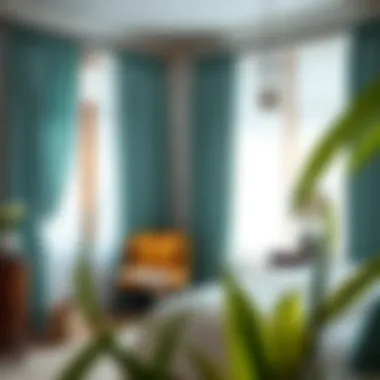

"Smart buying means knowing what you want and not settling for less. The right teal curtains can add the perfect splash of color without costing you a pretty penny."
Buying light teal curtains, whether for your home or a commercial space, requires delicate thought. Taking the time to understand quality and seek out value means you set the stage for lasting beauty in your interior design.
Custom vs. Ready-Made Light Teal Curtains
When it comes to decorating your home with light teal curtains, one important decision to ponder is whether to choose custom-made or ready-made options. Each choice has its own set of benefits and drawbacks that can heavily impact the overall aesthetic and functionality of a living space. Understanding these elements can guide homeowners, designers, and DIY enthusiasts toward the most fitting selection for their needs.
Weighing the Pros and Cons
Custom Light Teal Curtains
- Tailored Fit: One of the primary advantages of custom curtains is their ability to cater precisely to your window dimensions. For particularly large or uniquely shaped windows, custom curtains can prove invaluable.
- Endless Options: With custom options, you have the freedom to select the exact fabric, pattern, and features—such as lining, heading styles, and more. This level of personalization gives you control over how the curtains resonate with other design elements in the room.
- Quality Craftsmanship: Often, custom curtains are made with superior materials, ensuring that they last longer and retain their beauty over time. The attention to detail can be reflected in the stitching and overall finish.
However, the cons of custom curtains include:
- Cost: Custom curtains generally come with a higher price tag. You might find yourself splurging, especially when selecting high-quality fabrics and bespoke designs.
- Time-Consuming: The process of designing, ordering, and waiting for custom curtains can be lengthy, which might not suit those looking for immediate solutions.
Ready-Made Light Teal Curtains
- Convenience: The most notable benefit of ready-made curtains is their availability. These curtains can be picked up almost immediately, making them a quick solution for last-minute decorating needs.
- Affordability: In general, ready-made curtains are more budget-friendly. You can often find stylish designs without breaking the bank, and many options are available that carry a fashionable aesthetic.
- Variety: Retailers usually stock a range of designs and colors, allowing for easier comparison and selection.
On the other hand, ready-made curtains have disadvantages:
- Limited Customization: They often come only in standard sizes, which might not fit unconventional windows well, leading to an imperfect appearance.
- Quality Concerns: Some ready-made options may sacrifice durability or quality of fabric for cost, resulting in curtains that fade or wear more quickly.
Finding the Perfect Fit for Unique Spaces
Choosing between custom and ready-made light teal curtains can also hinge on the specifics of your space. For instance, if your home has unusually shaped or sized windows, opting for custom curtains may be the smarter route. A well-fitted curtain can elevate the room's overall look, making the windows appear more significant or more inviting than they are.
Conversely, for homeowners aiming to create a cohesive or transitional style in a set of standard-sized rooms—think living rooms with typical windows or bedrooms with straightforward designs—ready-made curtains may offer enough aesthetic appeal at a quicker pace. Many stores also provide responsive customer service, allowing measurements and specifications to be quickly clarified to ensure an accurate fit.
You might also want to consider the fabric and design characteristics tailored to particular themes. In a modern home, crisp, minimalist lines often look sharp with tailored, custom options, while a bohemian-style room may suit the more adventurous patterns of ready-made curtains.
In summary, both choices—whether custom or ready-made—bring their own sets of pros and cons. Evaluate your unique space’s needs, consider your budget, and recognize the importance of fitting aesthetics. This evaluation process can lead to a more harmonized and visually engaging interior design that resonates with your personal style.
Light Teal Curtains in Commercial Spaces
In the realm of commercial design, light teal curtains stand out as a versatile element that can significantly shape the overall ambiance of a space. Unlike the simple drapes or shades often ignored in an office or retail setting, these curtains hold the power to convey a brand’s identity while catering to the aesthetic needs of various environments. They not only serve as a backdrop but also interact with both natural and artificial light, creating a welcoming atmosphere for customers and employees alike.
Enhancing Ambiance in Retail and Hospitality
The role of light teal curtains in retail and hospitality cannot be overstated. They are particularly effective in spaces where creating a mood is crucial. Their soft hue provides a fresh, tranquil vibe, making customers feel at ease. For instance, a boutique draped in light teal can evoke a sense of calm that encourages shoppers to explore at their leisure. This can be significant, as studies suggest that people tend to spend more time in environments that feel comfortable and inviting.
Moreover, in restaurants or cafes, these curtains can enhance the dining experience. When the light teal fabric filters through sunlight, it creates a warm, inviting space that can improve the perception of food quality, ultimately contributing to customer satisfaction. Additionally, the color teal is frequently associated with balance and serenity, making it an excellent choice for spaces intended for relaxation and socializing.
"Creating a soothing environment is key in hospitality settings, and light teal curtains can genuinely transform an ordinary space into something memorable."
Considerations for Durability in High-Traffic Areas
While the aesthetic appeal of light teal curtains in commercial spaces is apparent, there are practical matters that need consideration too—especially in high-traffic areas. Durability becomes paramount in places like restaurants or retail stores where wear and tear is an everyday reality. Choosing fabrics that are durable yet stylish is crucial. Options like polyester blends can be beneficial for their strength and resistance to fading, making them ideal for sunny storefronts or busy kitchens.
Additionally, ease of maintenance cannot be ignored. In environments such as hotels or shops, light teal curtains should remain visually appealing though constant exposure to dust and oils from hands. It’s wise to select materials that are easy to clean or even machine washable.
In terms of installation, ensuring proper fittings and reinforcements can prolong the life of these curtains. Heavy-duty rods or tracks may avoid sagging and provide smoother operation, especially in areas where curtains are frequently opened or closed to control light or privacy.
Overall, integrating light teal curtains into commercial spaces offers both aesthetic and functional advantages, enhancing not only the environment but also customer experience.
Cultural Influences and Color Perception
Understanding the relationship between color and culture when it comes to interior design is crucial when selecting features like light teal curtains. These curtains do not merely serve as a decor element; they reflect deeper cultural meanings and perceptions. Different cultures interpret colors through unique lenses, creating a tapestry of significance that varies from one society to another. This aspect enlivens the selection process as homeowners and designers navigate their spaces.
How Culture Shapes Color Selection
Color selection in any home is often guided by the cultural background of its inhabitants. For instance, in Western cultures, light colors, such as light teal, are frequently linked to ideas of tranquility and freshness. In these settings, using light teal curtains can evoke a sense of serenity, making them ideal for bedrooms or relaxation areas.
In contrast, in Eastern cultures, light teal may possess different connotations. It can symbolize harmony and balance, aligning perfectly with the principles of Feng Shui, which many Eastern homeowners consider when designing their spaces. Therefore, someone from a culture that values these principles might choose light teal curtains not just for their aesthetic appeal but for the broader significance they carry in promoting positive energy.
This cultural lens emphasizes the need to approach color selection thoughtfully. When light teal becomes part of a home’s ambiance, it can bridge various cultural narratives, allowing individuals to express personal taste while remaining cognizant of their heritage.
Symbolism of Teal in Various Cultures
Teal, precisely light teal, bears a rich symbolism across various cultures. Here are a few notable perspectives:
- Western Cultures: In many Western contexts, teal is associated with peace and emotional balance. Its calming nature can create a soothing environment, making it a companion to spaces meant for relaxation.
- Eastern Cultures: Many Asian cultures view teal as a shade of healing. Specifically, it’s said to inspire creativity and calm the mind, often utilized in spaces intended for meditation or contemplation.
- Middle Eastern Cultures: Teal often represents prosperity and protection in Middle Eastern traditions. The use of light teal curtains in a living room or hospitality environment can evoke feelings of warmth and abundance.
- Indigenous Symbolism: In some Native American cultures, colors close to teal can represent water and the natural world, which can signify life, flow, and renewal. Incorporating light teal curtains may connect inhabitants to their roots, bringing a part of nature inside the home.
By understanding these cultural connections, one can make informed choices about integrating light teal curtains into their interior design, enhancing the ambiance while honoring the rich traditions associated with the color. This respectful acknowledgment can resonate deeply, creating a space that feels both comforting and personally significant.
"The color a person chooses ultimately tells their own story as much as it reflects the stories of those that came before them."
Trends in Curtain Design and Color
In the ever-evolving world of interior design, the choice of curtains transcends mere functionality. Light teal curtains, in particular, have carved a niche for themselves in modern design aesthetics, marrying style with practicality. This section explores why staying attuned to trends in curtain design and color is essential.
"Colors speak louder than words, especially in the space we inhabit."
Curtains can dramatically alter a room’s mood and functionality. Light teal, with its refreshing and tranquil tones, has become increasingly favorable among homeowners and designers alike. The synergy it creates when paired with other design elements makes it a versatile choice for various settings, whether chic urban lofts or cozy suburban homes.
Current Market Preferences
When examining current trends, one can’t help but notice a shift toward lighter, more serene color palettes, and light teal has emerged as a frontrunner. Homeowners are gravitating toward shades that inspire calm and relaxation, reflecting a collective yearning for peace in our bustling lives.
Key preferences in the market include:
- Translucent Fabrics: These materials let natural light filter through while maintaining privacy, enhancing the soft ambiance that light teal brings.
- Eco-friendly Options: There's a growing demand for sustainable curtain materials, catering to environmentally-conscious consumers.
- Customization: More people wish to express their individuality, leading to a surge in requests for bespoke designs that suit their unique tastes and spaces.
These preferences not only underline the importance of color but also reflect a broader trend in seeking balance and harmony within our homes. Designers are embracing lighter fabric that complements light teal, urging clients to experiment with textures and layers, effectively breaking the monotony of solitary hues.
The Future of Indoor Textile Trends
Looking ahead, the future of indoor textile trends seems poised to further embrace creativity and individuality. Light teal curtains are likely to be at the forefront of this movement, fueled by innovative designs and sustainable practices. Some anticipated trends include:
- Further Integration of Technology: Smart textiles that adapt to lighting and climate conditions may soon become common, making even light teal curtains a flexible asset in the home.
- Biophilic Design: Aiming to create a connection with nature, light teal works harmoniously with natural materials, promoting well-being and tranquility.
- Layering Techniques: As versatility reigns supreme, the layering of different materials will enhance curtain designs. Light teal pairs beautifully with solid or patterned sheers and valances, allowing for unique and personal combinations.
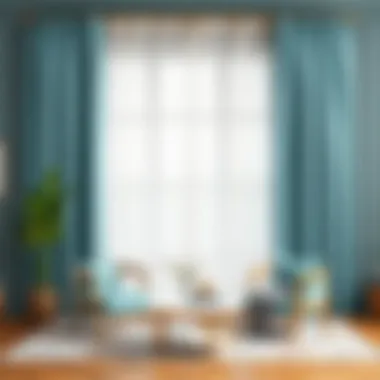

In summary, staying attuned to trends in curtain design and color proves vital for any homeowner or designer. Light teal curtains not only fulfill the practical need of covering windows but also elevate the aesthetic appeal of spaces, reflecting personal style and current preferences. By understanding and adapting to these trends, one can create inviting interiors that resonate with comfort and charm.
Experimenting with Layering Techniques
Layering techniques in interior design not only serve aesthetic purposes but also provide functional benefits that can transform the ambiance of a space. When it comes to utilizing light teal curtains, exploring these techniques can enhance both visual interest and the overall functionality of a room. Layering adds texture, depth, and versatility, allowing homeowners to create personalized and dynamic interiors.
Combining with Valances and Blinds
One popular layering approach is the combination of light teal curtains with valances and blinds. Valances, while being decorative, can act as a frame for your curtains. They can draw attention to the textures or patterns of the light teal fabric, creating a cohesive look. For instance, if you choose a solid light teal curtain, a patterned or contrasting valance at the top can introduce an exciting element. This contrast not only elevates the design but helps in defining the window space effectively.
Blinds, on the other hand, serve a functional role. They allow homeowners to control light levels while still having the visual impact of the light teal curtains. By opting for blinds in a neutral shade, the focus remains on the curtains without overwhelming the space. A well-thought-out layering can create a tailored, polished finish that speaks volumes about attention to detail.
"Layering is like building a story; each element adds to the narrative that your interior spaces speak to the world."
Utilizing Sheers for Added Dimension
Sheer fabrics are another excellent addition to your curtain game. When used alongside light teal curtains, they can provide a sense of lightness and elegance. The contrast between the opacity of light teal fabric and the translucency of sheers creates an ethereal feel, allowing natural light to filter softly through. This can bring a dreamy quality to living spaces, especially in rooms where natural light is an asset.
To experiment with dimension, one can hang sheers closer to the window while the light teal curtains are positioned further back. This design not only elongates the window visually but also enriches the layering effect, enhancing the overall aesthetic. When layered skillfully, sheer curtains can soften the edges of the room, adding a gentle touch and creating an inviting environment.
In summary, leveraging layering techniques with light teal curtains can dramatically enhance the interior aesthetic while also improving light control and privacy. These combinations allow for expression and adaptation to varying interior styles, making it a versatile approach in interior design.
Utilizing Curtains for Energy Efficiency
Light teal curtains can play a pivotal role in enhancing a home's energy efficiency. Many homeowners may not realize that the right window treatments can directly influence heating and cooling costs. By understanding how these curtains serve as both a decorative and functional element, one can substantially reduce utility expenses while improving comfort levels within a space.
Insulation Properties of Fabrics
When selecting light teal curtains, one should consider the fabric’s insulation capabilities. Heavier fabrics like velvet or thick linen provide better insulation by restricting warm air flow in winter and blocking heat during summer. The unique color of light teal adds an additional layer of appeal while functioning as an insulator. Several options include:
- Blackout curtains: These not only filter light effectively but also keep warm air in or cool air out, making them ideally suitable for energy conservation.
- Thermal-lined fabrics: Many curtains today come with built-in thermal lining. This provides enhanced insulation without compromising on style. The light teal hue can elevate the aesthetic while promoting energy saving.
These insulating properties significantly reduce the strain on HVAC systems, helping maintain a stable temperature year-round. Keeping a home snug yet stylish can easily go hand in hand.
Enhancing Airflow and Temperature Control
Light teal curtains, while visually appealing, contribute to airflow management. By utilizing curtains strategically, one can enhance natural ventilation, creating a fresher environment at home. Here’s how:
- Opt for lighter fabrics: Choosing lightweight materials will let air circulate freely while still adding a splash of color to the room. Voile or sheer fabrics in light teal allow soft breezes to flow through while also filtering sunlight gently.
- Positioning: The placement of curtains is fundamental. By affixing curtains higher and wider than the window, it encourages better airflow and opens up the space. The visual extension promotes an airy ambiance as well, making areas feel larger and more inviting.
- Curtain Length: Floor-length curtains can aid in temperature control and contribute to an elegant look. They operate as a barrier against drafts and sunlight, allowing for creative temperature regulation throughout different seasons.
Spotlight on Sustainable Materials in Curtain Production
In today’s conscientious world, where sustainability is no longer just a buzzword but a vital principle, the impact of materials in home décor cannot be overlooked. The shift toward eco-friendly choices in the production of light teal curtains has garnered attention, emphasizing how these selections can enhance interior design while adhering to environmental standards.
Light teal curtains don’t just make a statement aesthetically; they also serve as a canvas for new, sustainable practices in textile production. With growing awareness among homeowners, designers, and retailers, the conversation around sourcing and utilizing sustainable materials has evolved.
Promoting Eco-Friendly Choices
When selecting curtains, the materials that compose these panels can make a world of difference. Sustainable materials, like organic cotton or linen, are crafted without harmful pesticides or synthetic fertilizers. This not only benefits the wearer's health but also minimizes contamination of local ecosystems. Here are a few eco-friendly materials finding a home in the curtain market:
- Hemp: Touted for its durability and minimal environmental impact, hemp requires less water compared to conventional cotton, making it an enticing option.
- Recycled Polyester: Made from post-consumer plastic bottles, recycled polyester utilizes existing materials, keeping waste from landfills and reducing dependence on new resources.
- Bamboo: This rapidly renewable resource grows without the need for pesticides and is biodegradable, presenting a truly eco-conscious choice.
Promoting eco-friendly choices in curtain production not only decreases the carbon footprint but also pushes the interior design industry towards innovative solutions that match aesthetic desires with tangible benefits for our planet.
The Future of Eco-Conscious Design
As we gaze into the future of interior design, the potential of eco-conscious materials becomes increasingly inspiring. The home textiles market is gradually embracing this shift, with manufacturers investing in research and development to create sustainable fabric alternatives. Innovations such as plant-dyed fabrics offer eco-friendly color solutions without using synthetic dyes that pollute waterways.
Expect to see a rise in curtains that feature minimal waste production techniques and organic certification labels. Homeowners will demand more transparency regarding the sourcing processes of the products they choose. This shift is not just about producing green materials; it’s about integrating sustainability into every step of the design process.
In a world increasingly conscious of environmental challenges, opting for light teal curtains made from sustainable materials will likely redefine our living spaces. They allow your home to echo your values while still making a bold, stylish statement. By weaving together aesthetics and sustainability, light teal curtains can lead to a more harmonious relationship between design and the environment.
The Personalization of Home Spaces
Personalizing home spaces is fundamental to making a house feel like a home. Light teal curtains play a significant role in this personalization process, enabling homeowners to express their unique styles while addressing functional needs. They are more than just window coverings; they wield the power to tie together the aesthetic and practical elements of a room, creating a cohesive environment that mirrors individual tastes and lifestyles.
Incorporating light teal curtains can bring a fresh vibrance to an array of interior spaces. Color psychology suggests that teal hues can induce calmness and inspiration. Thus, homeowners often gravitate towards it when seeking to create soothing atmospheres. The act of selecting specific shades of teal and pairing them with other colors is a reflection of personal preference. For instance, choosing a more subdued teal can generate a serene feel, while a brighter shade might energize the space.
Besides color, patterns and textures can also personalize space. A light teal curtain with a delicate floral pattern might resonate with those who cherish a vintage aesthetic, whereas geometric designs can appeal to minimalists. This flexibility enables each homeowner to transform their space into a personal haven, showcasing individuality in design choices.
However, it’s not only about aesthetics; considerations regarding function and practicality also play a vital role in personalization. Suitable fabric can determine how well your curtain performs in terms of light filtering and insulation. This balance of beauty and utility ensures that your choice of light teal curtains doesn’t just look good but also enhances living conditions.
"Personalization is not merely about aesthetics; it intertwines style, comfort, and personal identity."
Expressing Individual Style with Teal
The choice of light teal curtains allows homeowners to express their individual styles in diverse and creative ways. Whether you are a design aficionado or someone just starting to explore home decor, these curtains can be a distinguishing feature that adds depth to a room without overshadowing other elements.
One way to express individual style is through color pairing. Light teal works beautifully with both warm and cool tones. Pairing them with warm wooden tones can create a cozy atmosphere, while contrasting them with cooler shades can make a room feel more contemporary. The adaptability of light teal as a neutral backdrop or a statement color fosters a level of personalization that speaks to the homeowner’s style preferences.
Furthermore, DIY enthusiasts will find that light teal curtains are an excellent canvas for creativity. Adding DIY embellishments or even modifying the length of ready-made curtains can create a unique touch that showcases individuality.
Beyond color and customization, light teal curtains invite creativity through layering. Draping them over heavier blinds or different fabric sheers can create a multi-dimensional look that reflects a more complex personal style. By mixing materials and textures, homeowners can achieve a unique design that’s genuinely their own.
Balancing Function with Aesthetic Appeal
When it comes to interior design, striking the right balance between function and aesthetic appeal can be challenging, yet it’s crucial for achieving optimal interior spaces. Light teal curtains excel in this aspect, serving both decorative and functional purposes without compromising on either front.
Functionality is a top priority for most homeowners. Light teal curtains can be crafted from materials that offer not only style but also performance. For example, blackout curtains in a light teal shade can block outside light effectively, ensuring that privacy and sleep quality are preserved, while allowing homeowners to embrace a color that resonates with their personal taste.
Simultaneously, the aesthetic appeal of these curtains can elevate a room from basic to beautiful. The soothing hue enhances the overall ambiance, creating a welcoming environment for family and guests alike. Moreover, the versatility of light teal means that it can seamlessly fit into various design themes, from coastal chic to modern minimalism, thus proving that functional elements need not lack style.
In summary, the careful selection of light teal curtains enables homeowners to balance their aesthetic preferences with the practical elements that enhance their living environment. The interplay of style and functionality signifies a well-thought-out personalization of space, promising both beauty and efficiency.
Closure: The Lasting Appeal of Light Teal Curtains
The journey through the roles and significance of light teal curtains in interior design leads us to a succinct yet powerful conclusion that emphasizes their multifaceted charm. At first glance, they might appear as a mere decor element, but their true influence stretches far beyond aesthetics. Light teal curtains serve both functional and visual purposes; they can transform a space and affect our moods, enhancing the quality of our daily lives.
Recapping the Multifunctional Roles
Light teal curtains aren’t just about aesthetics; they play numerous roles in a home’s ambiance and functionality:
- Natural Light Regulation: These curtains softly filter sunlight, allowing enough light to flow while preserving privacy. This is especially important in living spaces where comfort coexists with the need for bright surroundings.
- Temperature Control: Depending on the fabric, light teal curtains can help insulate a room, keeping it warm in winter and cool in summer. This quality makes them not only stylish but energy-efficient.
- Sound Absorption: Heavier fabrics can dampen noise levels, creating a calm retreat from the bustling world outside. This factor is pertinent in urban settings where peace often seems a luxury.
- Visual Cohesion: Integrating light teal curtains with other furniture and decor pieces can tie a room together, creating harmony and balance that feels cohesive to the eye.
"A well-chosen curtain does not just adorn the window; it serves as a bridge between the indoors and the outdoors, shaping perceptions and experiences alike."
Encouraging Thoughtful Selection in Design
When it comes to choosing light teal curtains, thoughtful consideration is paramount. The impact of color, fabric, and design must be weighed according to the specific needs of a space:
- Color and Mood: Light teal is often associated with the tranquility of the sea and sky. This color can evoke feelings of serenity and peace, making it ideal for bedrooms or relaxation spaces. A shade that may work well here might not be suitable for a more vibrant, active room such as a family area.
- Fabric Choice: Consideration of fabric type—whether lightweight sheers or heavier drapes—can affect not only the look but also the functionality of the curtains. In spaces with high foot traffic or direct sunlight exposure, durability will be a key consideration.
- Design Harmony: It’s advisable to select curtains that complement existing furniture and decor. A delicate floral pattern might enhance a vintage look, while solid designs can lend themselves well to modern, minimalist spaces.





